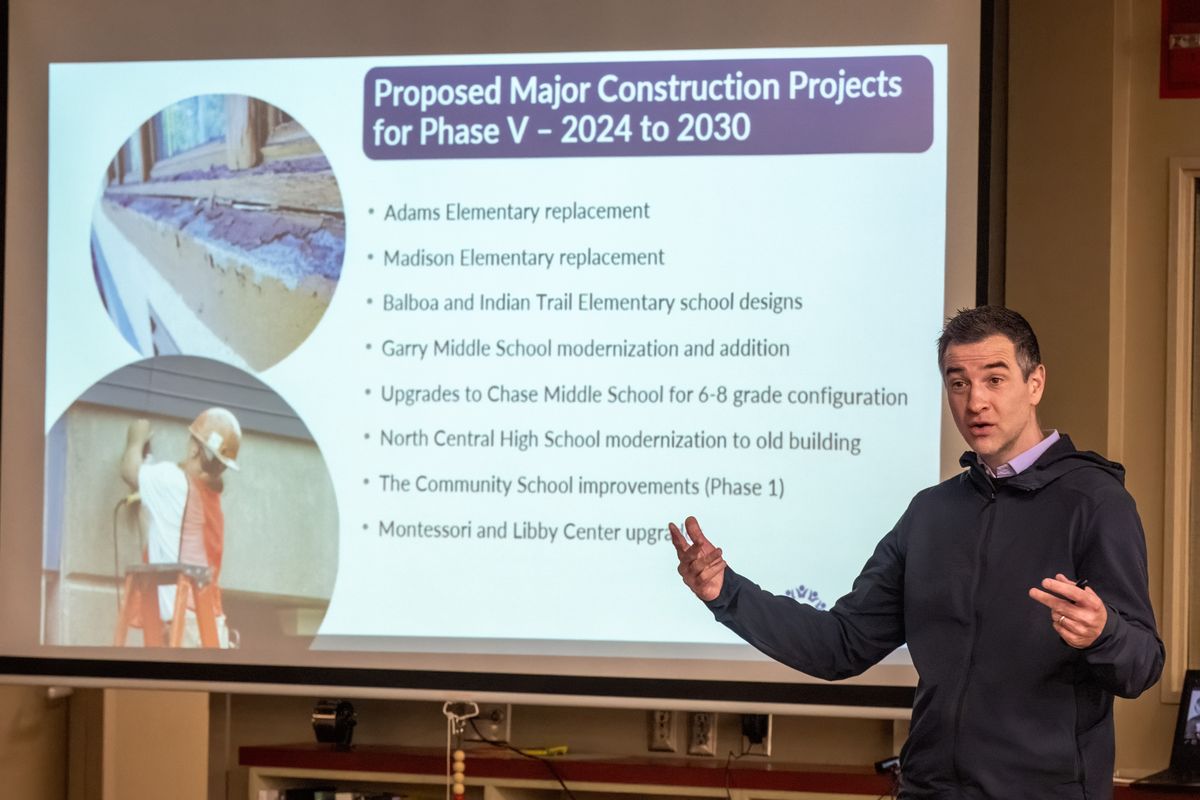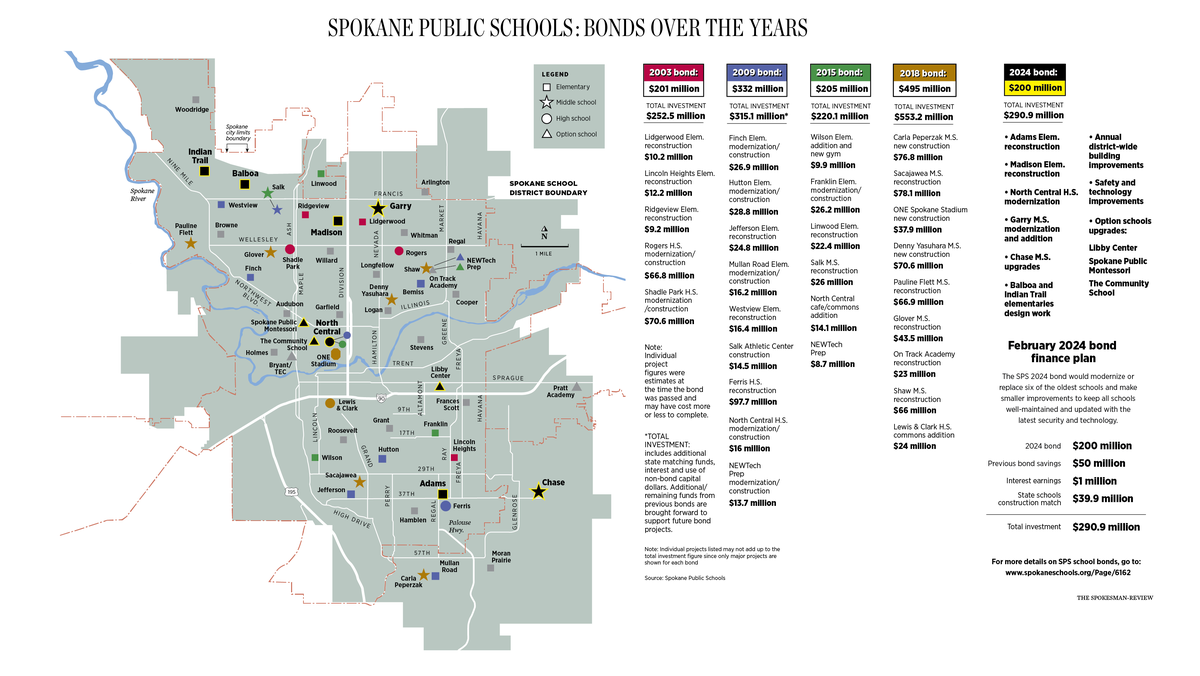Spokane Public Schools tax asks would continue extracurriculars, fund major projects at 10 schools
Spokane Public Schools Superintendent Adam Swinyard presents plans for the school levy and bond that will be on the February ballot during a community open house Tuesday at North Central High School. (COLIN MULVANY/THE SPOKESMAN-REVIEW)
Spokane Public Schools is asking voters for a levy and bond on February ballots, as part of a decadeslong cycle to maintain 57 facilities serving more than 29,000 students.
In a package that includes state matching funds and carryover funds from previous bonds and interest, 10 schools are considered major projects under the bond plan, with districtwide improvements and safety and technology also under the proposal.
“There’s 57 buildings, we’re playing the long game and we’re identifying the spaces in the most need,” Superintendent Adam Swinyard said in a December interview. “This is the most cost -efficient time to make that renovation because costs are only escalating.”
Among the oldest buildings in the district, Adams and Madison elementary schools would be replaced. North Central High School, which has been updated in past bonds, would be further modernized. Middle schools Chase and Garry would be upgraded and option schools Libby Center and Spokane Public Montessori would be renovated. Foreshadowing future bond proposals, the bonds would pay for designs to renovate the Community School along with Balboa and Indian Trail elementary schools.
The levy, which would authorize the collection of $297 million over three years at an estimated rate of $2.50 per $1,000 property value, would continue to support all extracurriculars, supplemental staff to lower class sizes and other facets of school that the state doesn’t pay for.
The district has generally sought a bond every six years since 2003. District taxpayers still are paying off a debt of about $616 million, according to data from the Spokane County Treasurer’s Office, from bonds approved by voters in 2009 and 2018.
The district has been successful in passing tax renewals historically, reaching the simple majority needed to pass a levy and the 60% required to pass a bond measure.
Past bonds have paid for major renovations on 29 of the district’s 57 buildings since 2003, including some new or replaced facilities like ONE Spokane Stadium and Sacajawea Middle School.
“This steady as you go approach is something our community has believed in since 2003 as a model for us to have schools that when kids go in them, they’re like ‘These are great spaces for learning,’ ” Swinyard said.
For those who own property in the Spokane school district, the district’s taxes constitute 39% of property owners’ 2023 tax bills. Adding in taxes collected by the state for schools, 61% of property taxes go toward schools in the form of voted and nonvoted levies.
Should the ballot proposals pass, projections for future tax rates for local schools would be around $3.86 per $1,000 property value for the three-year life of the levy, increasing by a few cents each year.
“The dollars that you pay out of your pocket for public education is going to be stable,” Swinyard said.
For 2024, the district will collect an estimated $3.82 per $1,000 in assessed property value. The average value of a property in the district is about $370,000. Using that figure, the average homeowner in Spokane Public Schools will pay $1,413 toward local schools this year. If the bond and levy pass, the amount paid by the average property owner next year is expected only to increase by about $64, in part, because some older bond debts will be paid off.
When property values increase districtwide, the amount each homeowner pays doesn’t necessarily increase in tandem. The district would be limited to collect the amount on ballots: $297 million in the levy over three years and $200 million over 20 years for the bond.
Some cringe at the near-half billion dollar tax ask. Natalie Poulson, who wrote the “against” statement for the proposals in voters’ pamphlets with former candidate for school board Erica Lalka, said that the taxes add too much of a strain on families during an already economically tumultuous time.
“It’s really not necessarily supporting kids and teachers and the overall help to people in our community when we are raising taxes to such a high amount in a time where it’s hard to pay for groceries and gas and insurance and everything else is just so expensive,” Poulson said.
Poulson is a former teacher in the district who publicly opposed mask and vaccine mandates and resigned and was escorted from her school for refusing to wear a mask at work. She ran unsuccessfully for a seat in the state House of Representatives in 2022.
Additionally, opposition argues that their taxes toward education aren’t paying off, with around 47% of students meeting state standardized test scores in English, over 35% in math and 39% in science. Districts should put more emphasis on improving academic success rather than aspects where levy funding is directed: school safety, mental and physical health centers.
“Our kids are failing, maybe all these extra things we’re putting in schools are not benefitting our kids,” Poulson said.
“Are we really doing our children any favors by leaving them in this astronomical debt?”
Jeremy Shay, president of the Spokane Education Association, the union that represents most the district’s workers, said levy funding contributes to “essentials” that keep schools operating the way they long have been: sports, art, some nurses, support staff and additional teachers.
“Without it, school would look very different than it is now,” Shay said.
The teacher’s union, Shay said, is always in support of levies and bonds passing.
“Even if we say no to this bond, Adams still needs to be replaced,” Shay said. “We’ll have to do it and the rest of these projects and additional projects in the next bond, it’ll be more expensive than to say we’ll just do it now.”
Editor’s note: This article has been amended to clarify Natalie Poulson’s resignation from the school district and correct the year she ran for office.

